Gedichtinterpretation von Oscar Wilde's "The Harlot's House"
This paper wants to examine Oscar Wilde’s poem “The Harlot’s House”. For that purpose, two steps seem necessary to me. Initially, the prosodic, metric and rhetorical elements and figures should be analysed in a sort of “survey” to get a first approach to the poem. Building on these observations, an interpretation will be attempted.
This paper wants to examine Oscar Wilde’s poem “The Harlot’s House”. For that purpose, two steps seem necessary to me. Initially, the prosodic, metric and rhetorical elements and figures should be analysed in a sort of “survey” to get a first approach to the poem. Building on these observations, an interpretation will be attempted.
Wilde’s poem is composed of 36 lines, which are arranged in twelve stanzas of equal length, each comprising three lines. The rhyme pattern is regular, each stanza is made up of a rhyming couplet and a single line rhyming with its equivalent in the following stanza (a-a-b c-c-b). All rhymes are true rhymes, eye-catching exceptions are the couplets “blind”-“wind” (9/12) and “false”-“waltz” (31/32). The metre is simple and regular as well, 35 lines are constructed as iambic tetrameters, the final line is shortened by one metric foot (catalexis).
The reader is introduced to a nocturnal setting; a pair of lovers, the male persona and his beloved, is lingering on a “moonlit street” (2) and stopping near “the harlot’s house” (3), which is obviously a brothel. The image of the couple’s solidarity is underlined by the usage of anaphora on the personal pronoun “we” (1/2, occuring again in the first position of line 5 and 10).
In the first few lines the acoustic phenomena predominantly attract the persona’s attention. The couple recognises that a party is occuring in the brothel by the tumultuos noise, which is clearly constrasting the romantic moonlit scenery. They can hear the sound of “dancing feet” (1), as a pars pro toto for the persons dancing inside the house; the hendiadys “din and fray”
(4) and the metonymy “loud musicians” (5) (actually the music is loud, not the persons who make it) focus on the acoustic perception. Ironically, the band inside the brothel plays a waltz titled “Treues Liebes Herz” (6), a song suggesting true love, which is just the opposite of what is the custom in such an establishment.
Attracted by the noise, the couple ventures a voyeuristic glimpse through the blinds at the actions that occur in the “harlot’s house”. They watch inhabitants and guests dancing to the music of the band, but everything which appears is illusion and shadow, mechanical and grotesque, emotionless and deathlike. The bizarre scenery is full of lifeless beings: “shadows” (9), “ghostly dancers” (10), “wire-pulled automatons” (13) and “slim silhouetted skeletons” (14). Every attempt to show real human emotions fails; dancing, singing and laughter can not get beyond mechanical and unemotional action:
Sometimes a clockwork puppet pressed A phantom lover to her breast,
Sometimes they seemed to try to sing. (19-21)
Seeing this grotesque scenery, the persona is directly addressing his beloved and condemning the persons and actions inside the “harlot’s house”. Instead of agreeing with his statement, “she - - she” (28), the anaphora contrasts the above mentioned pronoun “we” and clearly dissolves the couple’s solidarity, leaves her lover behind and enters the house because she is enchanted by the music. Her entrance, “she” (28) portrayed as the personification of “love” (30), must have affected the athmosphere in “the house of lust” (30), for the band’s “tune went false” (31) and the dancers, “wearied of the waltz” (32), stop dancing. The dissonance of the music is reflected in the off-rhyme “false” – “waltz” (31/32).
Thereupon, the next morning is already dawning, it appears personified as a young girl, who shyly passes the scene on “silver-sandalled feet” (35); besides the persona and his beloved, the “frightened girl” (36) is the only character described as having a human face. The contrast of night and dawn is empasised by the shortened metre of the last line.
[...]
- Citar trabajo
- Florian Unzicker (Autor), 2007, Oscar Wilde - "The Harlot's House", Múnich, GRIN Verlag, https://www.grin.com/document/122627
-

-

-

-
¡Carge sus propios textos! Gane dinero y un iPhone X. -

-
¡Carge sus propios textos! Gane dinero y un iPhone X. -

-
¡Carge sus propios textos! Gane dinero y un iPhone X. -

-
¡Carge sus propios textos! Gane dinero y un iPhone X. -

-
¡Carge sus propios textos! Gane dinero y un iPhone X.

